Kirkhill Heritage
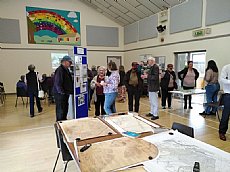 In Spring 2022, almost 50 people met in Kirkhill to explore the rich heritage of the parish. We began sharing memories, then turned to researching many of the sites, arefacts and stories which emerged. The group created a display and binder of resources, launched at the Open Days on Saturday and Sunday 18 & 19th June, 1-4pm at Kirkhill Community Centre, attended by over 160 people.
In Spring 2022, almost 50 people met in Kirkhill to explore the rich heritage of the parish. We began sharing memories, then turned to researching many of the sites, arefacts and stories which emerged. The group created a display and binder of resources, launched at the Open Days on Saturday and Sunday 18 & 19th June, 1-4pm at Kirkhill Community Centre, attended by over 160 people.
The course had three modules: first sharing memories, then researching various topics that had been thrown up, and finally creating a display and binders of resources. It was part of the FACET project, and had five trainees on the course, learning how to facilitate community heritage courses. The group took the Kirkhill parish area as their focus.
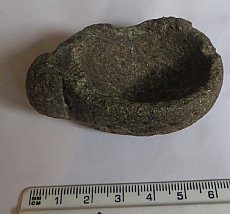 The prehistoric past of the area has in many places been obliterated by agricultural improvements and forestry, but some key finds bear witness to occupation from the Neolithic times onwards.
The prehistoric past of the area has in many places been obliterated by agricultural improvements and forestry, but some key finds bear witness to occupation from the Neolithic times onwards.
Before Culloden much of the parish near the coast was marshy, but extraordinary drainage works took place in the later 1700s and first half of the 1800s. There are even sea flaps at some reclaimed land.
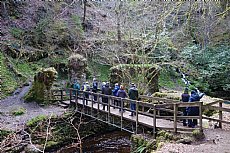 Many of the lairds were keen planters, and some special trees survive in a number of sites. The walks at Reelig Glen were laid out in the late 1700s and first half of the 1800s, with many of the bridges and grotto still visible. An elaborate lade was introduced in the 1800s, tapping the burn in one place, crossing over on a wooden aqueduct, and then leading to Reelig mill – with remnants of lade and aqueduct supports still to be seen.
Many of the lairds were keen planters, and some special trees survive in a number of sites. The walks at Reelig Glen were laid out in the late 1700s and first half of the 1800s, with many of the bridges and grotto still visible. An elaborate lade was introduced in the 1800s, tapping the burn in one place, crossing over on a wooden aqueduct, and then leading to Reelig mill – with remnants of lade and aqueduct supports still to be seen.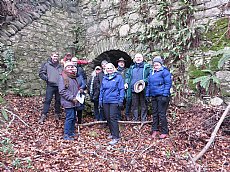
The Lovat estates were taken over by the government after Culloden. New ventures were introduced to improve profitability, including three short-lived limekilns, two of which still survive. A later venture near Reelig was on a larger scale, involving a tramway to bring the limestone from the quarry to the three large kilns. 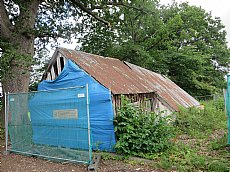
In Kirkhill itself the Wardlaw Mausoleum is well known. But less well known is Groam Cottage, an extremely rare example of an unmodernised 18th century cruck-framed dwelling. It went from unlisted to Grade A protection in record time!
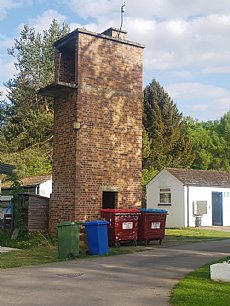 Wartime remains are scattered in the area as well. Very little remains of the WWI POW camp at Altnacardich where German POWs helped in forestry. More remains survive at the POW camp at Bunchrew Caravan Park, including a water tower and hut bases now used for caravans. Many of the large houses were taken over by military, incluing a large RAF presence at Lentran.
Wartime remains are scattered in the area as well. Very little remains of the WWI POW camp at Altnacardich where German POWs helped in forestry. More remains survive at the POW camp at Bunchrew Caravan Park, including a water tower and hut bases now used for caravans. Many of the large houses were taken over by military, incluing a large RAF presence at Lentran.
The project was able to build on the work of the Kilmorack Heritage Association which undertook historical research in the early 2000s. In addition we were able to use the fantastic Lovat Estate maps, now available on the National Library of Scotland website. A rich collection of old photographs collected by Charlie Gair provided a wide-ranging archive of information spanning the 20th century.
Results were submitted to the Highland Historic Environment Record, with the transcript featuring around 200 sites available on the Aird Community Trust website. The Trust will also make an online version of the display. Binders of resources are available at Inverness Reference Library and Wardlaw Mausoeum.
This course was part of the FACET project funded by Historic Environment Scotland, ARCH, a number of donations and the Hugh Fraser Foundation.
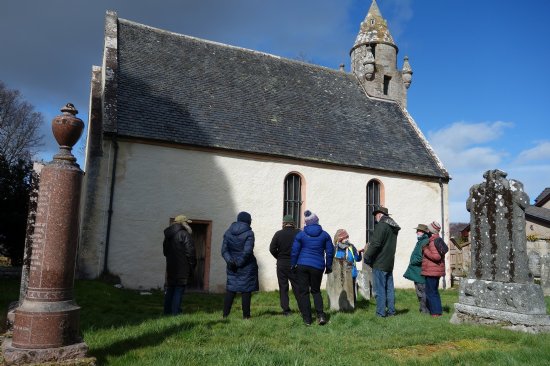
Latest News...
12/08/2025 - ARCH August 2025 Newsletter now available
The August 2025 ARCH newsletter is now available to download from the Library. It contains... More >>
30/03/2025 - Dingwall Station Online display
The latest online display available on the website is Dingwall Station, originally made du... More >>
27/02/2025 - ARCH February 2025 Newsletter now available
The February 2025 ARCH Newsletter is now available to download from the Library on the ARC... More >>
Site of the Month
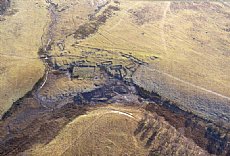 10/04/2021 - Easter Raitts township
10/04/2021 - Easter Raitts township
Easter Raitts township Photo: Highland HER Although the Highlands is dotted with de... More >>
Find of the Month
These stone vessels, many with handles, were found at a variety of sites in Sutherland and... More >>

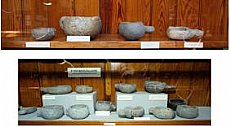 25/07/2022 - Steatite Vessels
25/07/2022 - Steatite Vessels